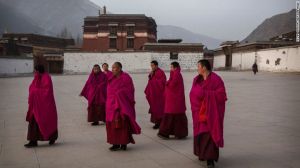Chinese and Tibetan Buddhism explained
Tibetan and Chinese Buddhism are two different practices that were formed on the same teachings.
In both Tibetan and Chinese Buddhism, the practitioner is trying to attain enlightenment, the ability to break away from the cycle of rebirth and suffering, known as samsara.
Buddhism in general is made up of three different levels of practice. These three are known as Hinayana, Mahayana and Vajrayana. To the first reincarnation of Kalu Rinpoche, an influential teacher in Tibetan Buddhism, the word ‘yana’ means vehicle and in this sense, the “means of advancing on the path” to enlightenment.
Chinese and Tibetan Buddhism include both Hinayana and Mahayana practices. However, Tibetan Buddhism practice is built around Vajrayana practices. The physical differences between Chinese and Tibetan Buddhist monks are plain to see, Tibetan Buddhist monks wear red.
Tibetan Buddhist monks dress in red.
The idea of these practices is for the follower to overcome samsaric activities. According to Kalu Rinpoche, this includes “intent on personal interest and ego-centered ambitions.” By overcoming these samsaric activities, the follower would then be able to attain enlightenment.
The first and most basic level of Buddhism is called Hinayana. It is also known as the individual vehicle. This stage involves the most basic Buddhist teachings. All effort by the practitioner is put into the individual attainment of enlightenment. Hinayana tells the individual follower to overcome samsaric activities through meditation.
The second level of Buddhism is called Mahayana. The main difference between this level and Hinayana is that the former includes the concept of compassion. In Mahayana, instead of attaining enlightenment individually, the practitioner is trying to develop bodhicitta – the ability to attain enlightenment and also, to use this to benefit all other living beings trapped in samsara. In order to achieve bodhicitta, the practitioner must begin at the very basics of Buddhist teachings and practices and then slowly make their way up to more advanced practices, until finally, he or she reaches nirvana.
Like Hinayana and Mahayana, the Vajrayana’s purpose is to transcend fixations of ego, attachment and indifference. Kalu Rinpoche also calls Vajrayana the “lightening path”. Though Vajrayana includes the teachings and practices from the other two levels of Buddhism, the main difference is that Vajrayana provides techniques, which expedites the process of attaining enlightenment and bodhichitta. Instead of taking the step-by-step approach of Mahayana, Vajrayana practices are comparatively advanced. This is because Vajrayana requires the practitioner to imagine himself or herself as the Buddha or other enlightened Buddhist deities during the process of the practice. In other words, the practitioner uses the perception that he or she has already achieved enlightenment, as the main vehicle of practice in order to attain enlightenment quickly.
The Differences in Practice
Tibetan Buddhism and Chinese Buddhism use the same basic Buddhist teachings. Chinese Buddhism has attracted many Chinese followers because it includes many aspects of Chinese culture and history. However, according to Lama Tenpel Choedrak, the Taiwanaese resident lama at a prominent Hong Kong Tibetan Buddhist practice centre, Tibetan Buddhism offers the follower a wider range of practices and rituals that are designed so that he or she may be able to reach enlightenment faster. Hong Kong is home to both Chinese and Tibetan Buddhism.
Hong Kong is home to both Chinese and Tibetan Buddhism.
“In Tibetan Buddhism, the ways of practice are diverse. There are also many schools of thought, different methods of practice, different deities.”
Because of this, many Chinese followers of Buddhism prefer Tibetan practices and rituals over Chinese Buddhism.
Chinese Buddhism practices are also more complicated. This is because Chinese Buddhism follows the step-by-step approach of Mahayana Buddhism. The follower is expected to make a slow but comprehensive approach to enlightenment which may seem complicated and time consuming. To Lama Choedrak, Chinese Buddhism practice is very serious. “There are strict ways to let you know how to do practice and how to learn Buddhism. It requires you to change more of your habits in daily life.”
Lama Choedrak believes that the fundamental difference between Chinese and Tibetan Buddhism lies within the faith’s influence on the lifestyle of the follower. Chinese Buddhism requires the follower to completely change his or her lifestyle in order to become a successful Buddhist. On the other hand, Tibetan Buddhism only requires the follower to change his or her perspective on life. “If you don’t want to change your lifestyle and habits, but you want to practice and then you will turn towards Tibetan Buddhism,” Lama Choedrak said.
Conclusion
The main factors that differentiate between Chinese and Tibetan Buddhism lie within the different approaches to enlightenment.
These differences are also the ones that distinguish between Vajrayana Buddhism and Mahayana Buddhism. Vajrayana Buddhism provides a quicker approach to enlightenment.
Expedited Buddhist practices are more valuable than the culturally familiar but complex practices of Chinese Buddhism, to many Chinese followers.
Source
https://blogs.ubc.ca/spiritualrenewal/tibetan-buddhism-explained/
